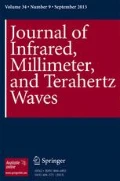Abstract
Investigations were carried out to develop terahertz (THz) techniques combined with machine learning methods for rapidly measuring benzoic acid (BA) additive in wheat flour. The absorption coefficient had a significant characteristic peak at 1.94 THz, which usually varies with the increase of BA additive concentrations. Correlation analysis was initiated to choose a frequency pair of 1.94 and 1.86 THz that improved the predictive ability of multiple linear regressions (MLR) model. Then, quantitative determination models were modeled between BA concentrations and THz absorption coefficients using partial least square (PLS) regression and least square support vector machine (LS-SVM). Compared with MLR and PLS models, the LS-SVM model could be regarded as an effective tool for quality control of wheat flour with a correlation coefficient of prediction (Rp) of 0.994 and root mean square error of prediction (RMSEP) of 0.12%. The results suggest that combining THz spectroscopy with LS-SVM has the potential to quantitatively analyze BA additive in wheat flour.





Similar content being viewed by others
References
M. Winter, A consumer’s dictionary of food additives, New York: Three Rivers Press (2009).
Y. Abe-Onishi, C. Yomota, N. Sugimoto, H. Kubota, L. Tanamoto. Determination of benzoyl peroxide and benzoic acid in wheat flour by high-performance liquid chromatography and its identification by high-performance liquid chromatography-mass spectrometry. Food Chem. 1004 (2004) 209–214.
S. K. Mathanker, P. R. Weckler, N. Wang. Terahertz (THz) application in food and agriculture: a review. T. ASABE. 56(3) (2013) 1213–1226.
J. Qin, Y. Ying, L. Xie. The detection of agricultural products and food using terahertz spectroscopy: a review. Appl. Spectrosc. Rev. 48(6) (2013) 439–457.
H. Ge, Y. Jiang, F. Lian, Y. Zhang, S. Xia. Quantitative determination of aflatoxin B1 concentration in acetonitrile by chemometric methods using terahertz spectroscopy. Food Chem. 209 (2016) 286–292.
Z. Zheng, W. Fan, B. Xue. Study on benzoic acid by THz time-domain spectroscopy and density functional theory. Chin. Opt. Lett. 9 (2011) 1–3.
L. Jiang, M. Li, C. Li, H. Sun, L. Xu, B. Jin, Y. Liu. Terahertz spectra of L-ascorbic acid and Thiamine hydrochloride studied by terahertz spectroscopy and density functional theory. J. Infrared Millim. Terahertz Waves. 35 (2014) 871–880.
W. Liu, C. Liu, J. Yu, Y. Zhang, J. Li, Y. Chen, L. Zhang. Discrimination of geographical origin of extra virgin olive oils using terahertz spectroscopy combined with chemometrics. Food Chem. 251 (2018) 86–92.
J. Liu. Terahertz spectroscopy and chemometric tools for rapid identification of adulterated dairy product. Opt. Quan. Electron. 49 (2017) 1–8.
Z. Li. Genetic algorithm that considers scattering for THz quantitative analysis. IEEE Trans. Terahertz Sci. Technol. 5(6) (2015) 1062–1067.
Z. Li, A. Guan, H. Ge, F. Lian. Wavelength selection of amino acid THz absorption spectra for quantitative analysis by a self-adaptive genetic algorithm and comparison with mwPLS. Microchem. J. 132 (2017) 185–189.
S. H. Lu, B. Q. Li, H. L. Zhai, X. Zhang, Z. Y. Zhang. An effective approach to quantitative analysis of ternary amino acids in foxtail millet substrate based on terahertz spectroscopy. Food Chem. 246 (2018) 220–227.
S. Lu, X. Zhang, Z. Zhang, Y. Yang, Y. Xiang. Quantitative measurements of binary amino acids mixtures in yellow foxtail millet by terahertz time domain spectroscopy. Food Chem. 211 (2016) 494–501.
J. Qin, L. Xie, and Y. Ying. Determination of tetracycline hydrochloride by terahertz spectroscopy with PLSR model. Food Chem. 170 (2015) 415–422.
L. Duvillaret, F. Garet, and J. Coutaz. A reliable method for extraction of material parameters in terahertz time-domain spectroscopy. IEEE Journal of Selected Topics in Quantum Electronics, 2(1996) 739–746.
P. U. Jepsen, D. G. Cooke, and M. M. Koch. Terahertz spectroscopy and imaging – modern techniques and application. Laser Photonics Rev. 5(2011) 124–166.
X. Zhang, J. Xu. Introduction to THz wave photonics, New York: Springer Verlag (2009).
S. Mehrkanoon, J. A. K. Suykens. LS-SVM approximate solution to linear time varying descriptor systems. Automatica 48(10) (2012) 2502–2511.
Z. Chen, Z. Zhang, R. Zhu, Y. Xiang, Y. Yang, P. B. Harrington. Application of terahertz time-domain spectroscopy combined with chemometrics to quantitative analysis of imidacloprid in rice sample. J. Quant. Spectrosc. Radiat. 167 (2015) 1–9.
Funding
This study received financial support from the Outstanding Youth Talent Program of Jiangxi Province (20171BCB23060), Education Department Project of Jiangxi Province (GJJ160478), China Scholarship Council (201808360317), Jiangxi Association for Science and Technology (JAST), and Doctor Start-up Program (368).
Author information
Authors and Affiliations
Corresponding author
Additional information
Publisher’s Note
Springer Nature remains neutral with regard to jurisdictional claims in published maps and institutional affiliations.
Rights and permissions
About this article
Cite this article
Sun, X., Zhu, K., Liu, J. et al. Terahertz Spectroscopy Determination of Benzoic Acid Additive in Wheat Flour by Machine Learning. J Infrared Milli Terahz Waves 40, 466–475 (2019). https://doi.org/10.1007/s10762-019-00579-z
Received:
Accepted:
Published:
Issue Date:
DOI: https://doi.org/10.1007/s10762-019-00579-z



